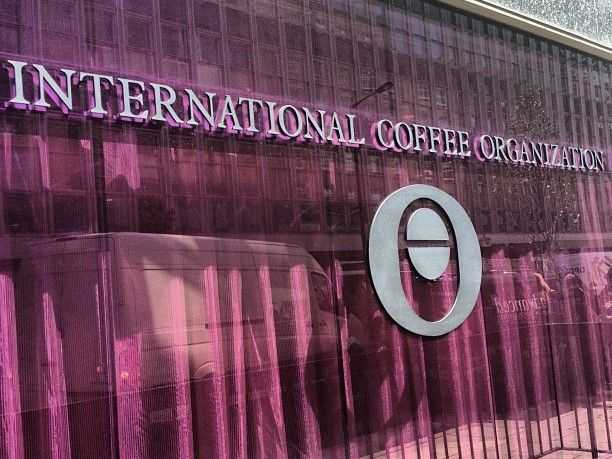LONDON, UK – The ICO composite indicator price averaged 114 US cents/lb in December 2017, down 2.8% from November 2017. Prices for all groups of coffee fell over the course of the month, though the steepest decline occurred in Robusta prices.
Exports in November 2017 were 9.2% lower than the same month last year on 9.02 million bags. Shipments of Arabica were 5.5% lower at 6.06 million bags while Robusta shipments decreased by 15.9% to 2.96 million bags.
Global coffee output for 2017/18 is preliminary estimated at 158.78 million bags, 0.7% higher than last year. Arabica production is provisionally estimated at 97.32 million bags, 1.1% lower than last year due to an expected reduction in output from Colombia and Brazil.
However, Robusta production is provisionally estimated 3.7% higher than last year at 61.46 million bags, due largely to growth in Vietnam.
In December 2017, the ICO composite indicator price averaged 114 US cents/lb, which is the lowest level since February 2016, when it was 111.75 US cents/lb. The indicator price started the month at 117.30 US cents/lb and then fell to a minimum of 110.48 US cents/lb on 12 December. On the last day of the month, the indicator price reached 115.88 US cents/lb.
Prices for all group indicators fell in December 2017 with Robusta experiencing the steepest decline and Colombia Milds, the smallest. The monthly average for the Robusta group decreased by 4.1%.
The average prices for Colombian Milds, Other Milds and Brazilian Naturals were down 1.7%, 2.5% and 2.3%, respectively.
The average arbitrage in December, as measured on the New York and London futures markets, decreased by 3.2% to 46.95 US cents/lb. Meanwhile intra-day volatility of the ICO composite indicator price declined by 0.2 percentage points to 5.2%, which is the fifth consecutive month of decrease.
Total shipments in November 2017 came to 9.02 million bags, less than the 9.93 million bags exported in the same month of the previous year. Compared to one year ago, shipments of both Arabica and Robusta declined in November 2017 to 6.06 million bags and 2.96 million bags, respectively. Total exports for the first two months of coffee year 2017/18 were 11.3% lower than in the previous year at 17.62 million bags.
World coffee production in 2017/18 is provisionally estimated at around 158.78 million bags, which represents an increase of 0.7% compared to 2016/17, which has been revised up to 157.69 million bags.
Total production of Arabica is estimated to decrease by 1.1% to 97.32 million bags compared to 98.42 million bags last year, as lower production of Colombian Milds and Brazilian Naturals are only partially offset by increases in Other Milds. An increase of 3.7% is expected in Robustas, due largely to a rebound in Vietnam, the world’s largest Robusta producer.
After reaching 55 million bags in 2016/17, Brazil’s output is estimated to decline to 51.5 million bags in 2017/18. Compared to crop year 2016/17, production of Arabica decreased by 6.4% to 38.63 million bags.
In addition to the expected biennial downturn of the Arabica crop, smaller bean sizes and an outbreak of the coffee berry borer also contributed to the decline in production. Brazil exported 2.79 million bags of coffee in November 2017, 15% lower than one year ago. Its shipments in the first two months of coffee year 2017/18 are estimated at 5.66 million bags, a decrease of 14.7% compared to one year ago.
In 2016/17, Vietnam’s production declined by 11.1% to 25.54 million bags due to overly hot and dry weather. However, output in Vietnam is provisionally estimated to increase to 28.5 million bags in crop year 2017/18, 11.6% higher than in the previous year.
Sufficient rainfall for crop year 2017/18 is expected to improve nutrient uptake and increase yields. Exports during the first two months of crop year 2017/18 are estimated at 3.08 million bags, down 19.4% from one year ago as excessive rains have delayed harvesting of the new crop.
After increasing over the last five crop years, production in Colombia is provisionally estimated to decrease by 4.3% to 14 million bags as heavy rains caused damage during the flowering of the trees.
In the last few crop years, Colombia’s output has expanded due to replanted coffee trees coming into production and beneficial weather. Shipments from Colombia are estimated at 2.29 million bags for the period October to November 2017, 10.5% lower than the same period one year ago.
In Indonesia, a decrease in production of 6% to 10.8 million bags is provisionally expected in crop year 2017/18 due to lack of good farm management and excessive rains.
On the other hand, output in Honduras is expected to rise by 12% to 8.35 million bags, which would be the fourth consecutive season of growth. Indonesia’s exports in October-November 2017 are estimated down 41.6% to 0.96 million bags compared to last year while Honduras’s shipments during the same period increased by 1.7% to 0.22 million bags.
The Coffee Board of India has indicated that it expects production to increase by 12.3% to 5.84 million bags due to beneficial rains during the fruit setting period as well as an expected increase as Arabica production enters its on-year in the biennial cycle. Smaller increases are expected provisionally in Ethiopia, Uganda, Peru and Mexico.
The full report is available at this link.


















